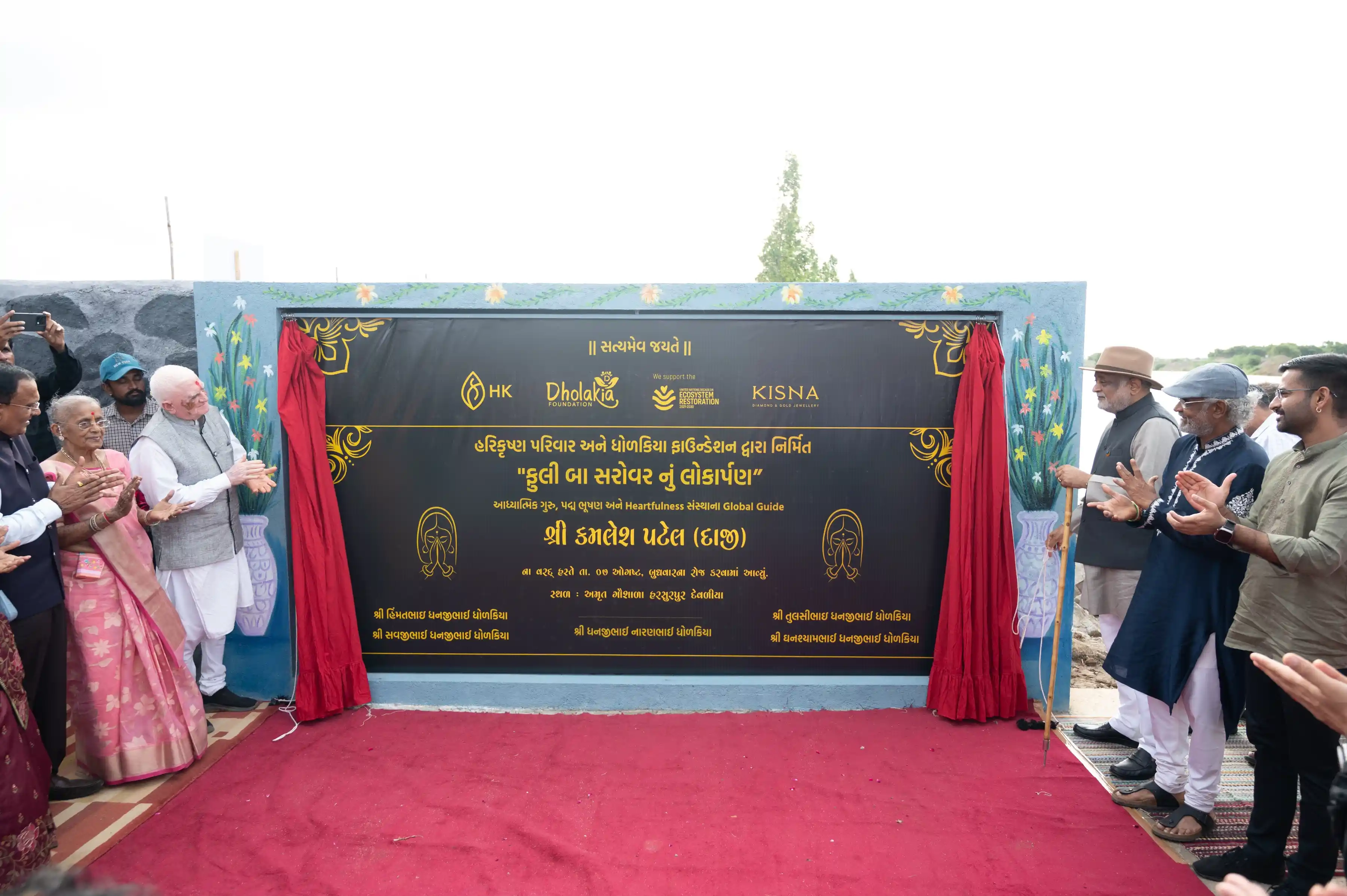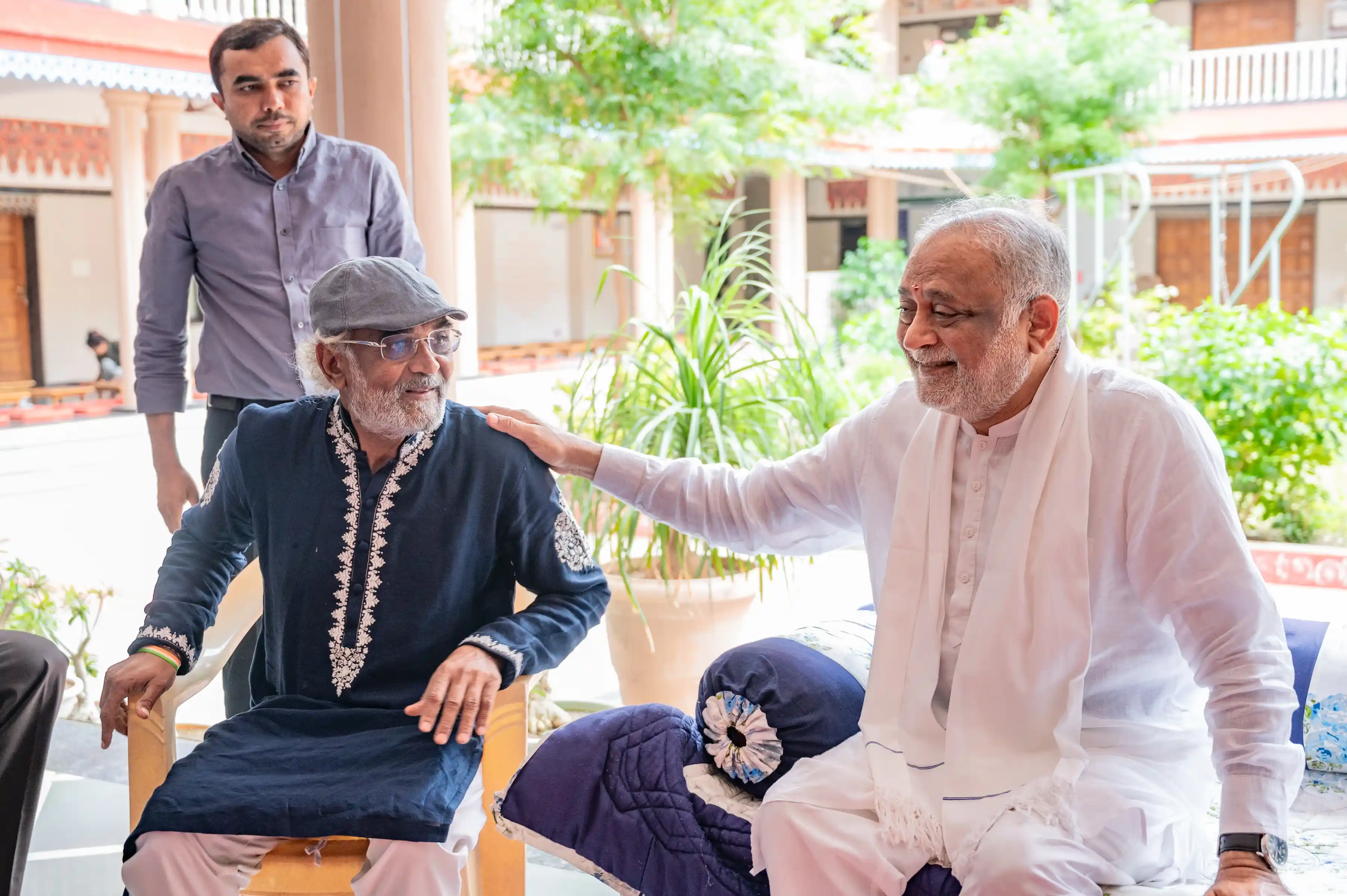A live journal of blessed activities in and around Kanha with Daaji
Simple tips to avoid making mistakes by Daaji
Archive
Last 5 entries
Amreli, Gujarat 7th August 2024
After Vadodora, Daaji visited Amreli, located in the south-eastern part of Gujarat. Daaji had been invited by Padma Shri awardee Shri Savjibhai Dholakia to inaugurate the reservoir-lake at his estate, Het ni Haveli, which is also the site of the Dholakia Foundation. At the evening session, Savjibhai introduced Daaji to the audience with much reverence, after which Daaji gave a short talk in Gujarati.
Daaji, in his speech, said, “If Lord Krishna comes and stays with you for a few months after being pleased with your devotion, you will be exhausted within two days only. You will say, “Oh, Lord! Please leave, you are not allowing me to do anything. You keep saying ‘don’t do this, don’t do that’.” Because your independence is over when you are one with the Lord. And today’s man is a lover of independence—“Let me do what I want, even if the Lord says ‘no’.” So, if this is the feeling in your heart and you can't even keep the Lord for two days with you, then why do you worship and perform rituals—lamps, incense, tilak [red vermillion mark on the forehead], etc.? That is why the Gujarati poet Narsinh Mehta wrote, ‘Hari no maarag che shuraa no, nahi kaayar nu kaam jone’ [Heed this! The path to God is for the brave-hearted, not for the cowardly].”
Daaji’s Gujarat trip had a packed itinerary, starting from Surat and Navsari in South Gujarat, then heading north to Vadodara, before turning westwards towards Bhavnagar. He reached Bhavnagar on 6 August by nightfall after a few hours’ drive. The next morning, after conducting meditation, He left for Amreli, the capital of Amreli district, which is located in the south-western part of Gujarat.
Daaji had been invited by Padma Shri awardee Shri Savjibhai Dholakia to inaugurate the reservoir-lake at his estate, Het ni Haveli, which is also the site of the Dholakia Foundation. The Dholakia Foundation is the philanthropic arm of Hari Krishna Group, founded in 1996 by Savji Dholakia, Himmat Dholakia, Tulsi Dholakia, and Ghanshyam Dholakia. The foundation embodies their commitment to societal and environmental well-being, particularly through initiatives aimed at ecosystem restoration and sustainability in India.
At around 5 o’clock in the evening that day, Daaji reached Het ni Haveli. After many warm greetings, Savjibhai took Daaji on a tour of the estate. Each step of the way, Daaji engaged in conversation with Savjibhai and his team as they showed him the foundation’s endeavors in ecosystem restoration at the estate. At the gaushala (cow shed), Daaji fed the cows by hand. It was a unique moment—a glimpse reminiscent of Daaji’s formative years growing up in a village which instilled in him a deep love for the soil, water, flora, and fauna.
The reservoir lake to be inaugurated was named in memory of Savjibhai’s late mother Smt. Fuliba. In a simple ceremony, Daaji unveiled the commemorative plaque and after which he planted a peepal tree at the site. Savjibhai, accompanied by a few others, took Daaji on a boat ride across the lake.












At the evening session, Savjibhai introduced Daaji to the audience with much reverence, after which Daaji gave a short talk in Gujarati. Here are some translated excerpts from it:
- In 1929, my Adi Guru, Shri Ram Chandra Ji (affectionately known as Lalaji), was invited by his disciple to the Marva District in Madhya Pradesh. Lalaji was so mesmerized by the natural beauty and spiritual atmosphere of the place that he compared it to the famous ashram of Kakbhushundji, which finds mention by poet Tulsidas in the Ramayana: it says that whoever meditates in the atmosphere of Kakbhushundji’s ashram will undoubtedly attain liberation and when one meditates in such an atmosphere, the Samadhi-like condition develops quickly. After reading Lalaji’s description of the place, I decided to visit it. In 2009, when I reached it, I was reduced to tears, for a barren land greeted me. There was no sign of greenery, not a single tree remained; all had been cut down. It was the exact opposite of the description I had read. So, I decided to contribute my efforts to support Nature’s work. Today, in Kanha—a place that was once rocky, barren land with only 500-600 mm of annual rainfall—we have created a lush green landscape.
- In particular, it has been mentioned in the Vedas that no life can exist on earth without water. And in the future, when there will be great wars, they will be over water. In our country, we have abundant rains, even if it is 300 or 500 mm; so, it is of vital importance to learn how we can save that water, store that water. Collect rainwater, boil it and drink it; it has several health benefits, and is better than the RO (Reverse Osmosis) water that we all drink nowadays.
- When a yogi transmits pranahuti (yogic transmission) to trees and plants, they retain this transmission long after the yogi is no more. However, this is not the case with humans—when a human receives yogic transmission, he/she is unable to retain it even for a few seconds. Thus, while humans possess the ability to move forward, they also have an equal potential to regress.
- If Lord Krishna comes and stays with you for a few months after being pleased with your devotion, you will be exhausted within two days only. You will say, “Oh, Lord! Please leave, you are not allowing me to do anything. You keep saying ‘don’t do this, don’t do that’.” Because your independence is over when you are one with the Lord. And today’s man is a lover of independence—“Let me do what I want, even if the Lord says ‘no’.” So, if this is the feeling in your heart and you can't even keep the Lord for two days with you, then why do you worship and perform rituals—lamps, incense, tilak [red vermillion mark on the forehead], etc.? That is why the Gujarati poet Narsinh Mehta wrote, ‘Hari no maarag che shuraa no, nahi kaayar nu kaam jone’ [Heed this! The path to God is for the brave-hearted, not for the cowardly].
Towards the end of the talk, Daaji offered an opportunity to the representatives of 52 villages. He asked a Village Chief about the approximate acres of pasture or government land present in the villages. Working out some quick math, Daaji suggested, “If each village has an average of 20 acres, we can plant 400 sandalwood saplings per acre, totaling 8,000 trees. In 15 years, with today’s price of 4 lakh INR per tree, this could generate 320 crores. The money will go to the village. Ask in your villages who will join the cause and what they can contribute. Those who contribute more will receive more monetary benefit. We (Heartfulness) will provide the saplings free of cost, and if you'd like to contribute, you’re welcome to do so. If not, no worries.
“Along with this kind of material revolution, we must also bring a spiritual revolution in every village. We can set a day and time to gather here in this hall, treating it as an ashram, for meditation. Those willing can come together and once you have decided, please inform Savjibhai so we can arrange a preceptor for you all. Namaste.”




After the meditation session and a felicitation of the village representatives, Daaji retired for the rest of the day. The next morning, after yet another meditation session, he left for Jamnagar.